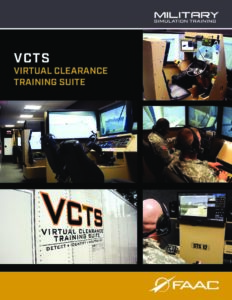FAAC’s latest generation of custom Combat Convoy Simulator (CCS) unleashes the full potential of immersive simulation-based training for convoy operations and dismounted small-unit tactics (SUT). CCS supports more advanced simulations and scenarios, including: command and control procedures, communications systems, and crew responses to improvised explosive device (IED) attacks, ambush attacks, evolving enemy tactics, and countermeasures. FAAC has extensive experience modeling IEDs and Counter Improvised Explosive Device (C-IED) systems and capabilities, and their interaction with vehicles and communications systems. Current CCS simulate both Chameleon and Hunter jammers, and accurately models the jamming effectiveness based on terrain and conditions.
In 2019 FAAC began upgrading USMC Combat Convoy Simulators throughout the U.S. Many of these systems had been in operation for 12+ years. While these were advanced systems when they were originally fielded, they had aged, and their simulation capabilities were lacking:
- Steering wheels and pedals had no force-feedback systems—they were more akin to arcade game controls than a real vehicle
- All software/hardware was “closed”—proprietary components and platforms made for extremely cumbersome maintenance, upgrade, and scenario authoring
- Dismounted soldier tracking and simulation was rudimentary, hampering SUT and combat training
- In-simulation vehicle dynamics and physics were totally absent
FAAC audited the system and discovered that many components (including cabs, gunner turrets, small arms, etc.) could be upgraded and modified for reuse. We replaced computer hardware, projectors/displays, actuators, software, and networking equipment with commercial-off-the-shelf (COTS) and open alternatives when available, leveraging existing USMC systems and software investments. (This approach regularly reduces development time by 6 to 9 months and saves millions of dollars in procurement costs, while also significantly reducing risk.)


















